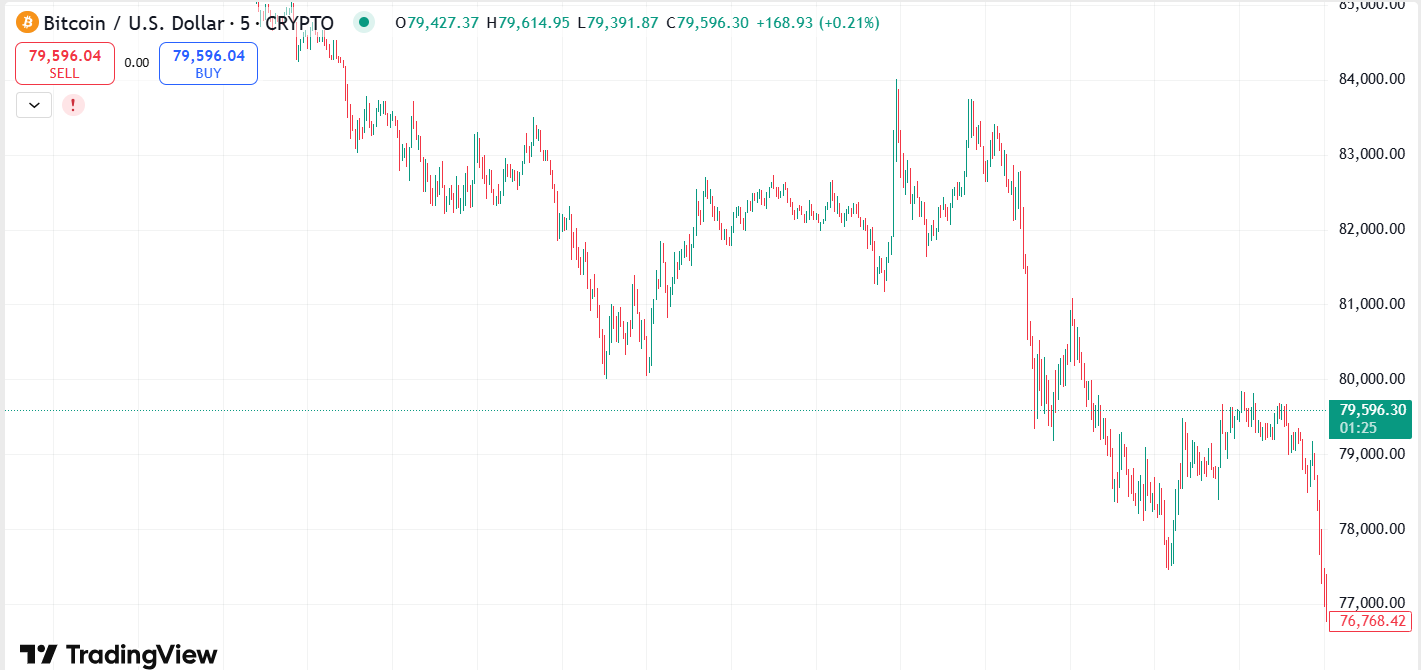
Bitcoin and Ethereum continued their downward spiral on Monday as investors anticipated key inflation data and potential Federal Reserve policy shifts. Meanwhile, Wall Street also saw a sharp selloff, reflecting growing economic uncertainties and cautious sentiment across global markets.
Market Overview: Stocks and Crypto in the Red
The stock market faced significant losses, with the S&P 500 falling 2.6%, the Nasdaq-100 dropping 3.1%, and the Dow Jones Industrial Average sliding 2.2%. Futures for Japan’s Nikkei 225 and Hong Kong’s Hang Seng Index signaled further losses, underscoring global economic stress.

Crypto mirrored these declines, with Bitcoin plummeting 5.8% to $76,838 and Ethereum tumbling 11.5% to $1,795 over the past 24 hours, according to CoinGecko. Both assets have suffered significant declines over the past month, down 19% and 29%, respectively.
Despite some positive regulatory signals, risk assets remain under pressure as uncertainty over capital flows, interest rates, and inflation weighs on investor sentiment.
Trump’s Pro-Crypto Move: Will It Impact the Market?
Amid the market downturn, former President Donald Trump is reportedly preparing an executive order aimed at reversing the Biden-era anti-crypto banking policies. Sources indicate that the order could roll back restrictions tied to Operation Chokepoint 2.0, which allegedly targeted crypto firms.
Additionally, the order may address stablecoin classification and Federal Reserve banking policies, reinforcing Trump’s commitment to a pro-crypto stance. His recent push to establish a U.S. Bitcoin reserve further highlights his administration’s shifting attitude toward digital assets.
Inflation Data in Focus: Will It Delay Fed Rate Cuts?
Investor attention is now squarely on Wednesday’s Consumer Price Index (CPI) report, which is expected to show a 0.3% rise in February prices, down from 0.5% in January. The year-over-year CPI is projected at 2.9%, slightly lower than the 3% reported last month, while core inflation is forecast to hold steady at 3.2%.
A higher-than-expected inflation reading could push the Federal Reserve to delay interest rate cuts, which could further pressure both the stock and crypto markets.
Liquidity Trends: A Silver Lining for Crypto?
While market conditions remain challenging, some analysts see potential relief for crypto in the coming months.
- M2 money supply expanded in 2024 but has remained flat this year, keeping risk assets in check.
- The Federal Reserve’s balance sheet has continued to shrink, currently at $6.75 trillion, down from $9 trillion in April 2022, as part of its quantitative tightening (QT) policy.
- Analysts suggest that the sharp decline in the U.S. dollar’s value could boost asset prices in the coming months, as liquidity trends typically act with a lag.
According to Jamie Coutts, chief crypto analyst at Real Vision, previous dollar declines have historically led to higher crypto and stock prices within two to three months.
Trade Tensions and Market Volatility Ahead
Despite potential liquidity boosts, trade tensions between the U.S., China, and Canada could further strain global markets. The upcoming U.S. tariffs, set to take effect next month, are raising concerns over an economic slowdown and higher inflation.
With the U.S. federal budget report and inflation data due this week, market volatility is expected to persist. However, Trump’s push for pro-crypto policies and shifting liquidity trends could set digital assets on a different trajectory from broader risk markets in the coming months.
Read Also: How Traders Are Getting Cheated by Pump.fun Launchpad: A Detailed Overview of These Malpractices

